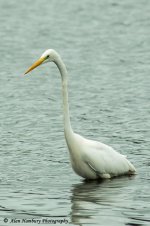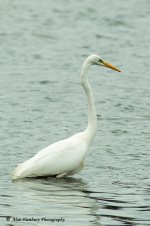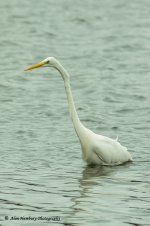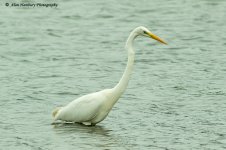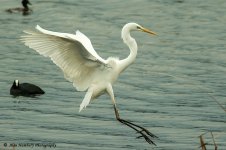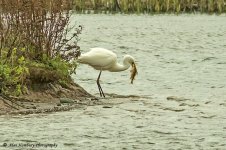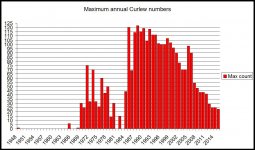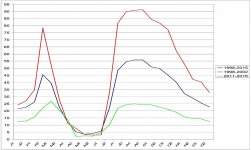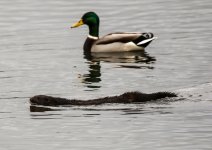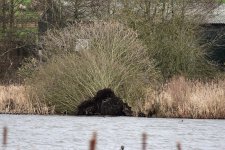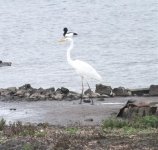-
Welcome to BirdForum, the internet's largest birding community with thousands of members from all over the world. The forums are dedicated to wild birds, birding, binoculars and equipment and all that goes with it.
Please register for an account to take part in the discussions in the forum, post your pictures in the gallery and more.
You are using an out of date browser. It may not display this or other websites correctly.
You should upgrade or use an alternative browser.
You should upgrade or use an alternative browser.
Upton Warren (136 Viewers)
- Thread starter andythomas
- Start date
More options
Who Replied?Phil Andrews
It's only Rock and Roller but I like it

Great White Egret still at the Moors Pool this morning as per Gary Palmer
upstarts1979
Well-known member
Biking Birder
Gary Prescott will be finishing his Year long round Britain Birding Tour at Upton Warren on 31st December. More details as and when we get them. Phil probably knows more:t:
Gary Prescott will be finishing his Year long round Britain Birding Tour at Upton Warren on 31st December. More details as and when we get them. Phil probably knows more:t:
Phil Andrews
It's only Rock and Roller but I like it

Gary Prescott will be finishing his Year long round Britain Birding Tour at Upton Warren on 31st December. More details as and when we get them. Phil probably knows more:t:
Gary is currently putting his feet up for a few days at his parent's house in Romsley ahead of doing it all again next year with the express target of breaking the European Green Birding record of 305 species in 2016. His movements for the rest of this year are as follows:
27th Romsley to Middleton
28th Chasewater (for Caspian Gull)
29th Belvide
30th Sandwell Valley
31st Upton Warren
Phil Andrews
It's only Rock and Roller but I like it

Early morning update from Dave J at the Moors Pool:
Great White Egret, 21 Pochard, 3 Meadow Pipit, 2 Gadwall, 120 Teal
First light at the Sailing Pool:
3 Little Egret, 2 Egyptian Geese again with Canadas
Great White Egret, 21 Pochard, 3 Meadow Pipit, 2 Gadwall, 120 Teal
First light at the Sailing Pool:
3 Little Egret, 2 Egyptian Geese again with Canadas
Last edited:
Phil Andrews
It's only Rock and Roller but I like it

Dave J's update from the Flashes:
Redshank, 2 Egyptian Geese, Meadow Pipit, Skylark, 70 Teal (190 on reserve) - total of 65 species
Redshank, 2 Egyptian Geese, Meadow Pipit, Skylark, 70 Teal (190 on reserve) - total of 65 species
AlanH46
Well-known member
Moors Pool
Great White and Little Egret this morning.
Around lunchtime GWE landed in front of west hide channel; within minutes it had caught sizeable Perch which it carried onto one of the islands to eat. Although it was eventually successful it took about 20 minutes to swallow the fish.
Great White and Little Egret this morning.
Around lunchtime GWE landed in front of west hide channel; within minutes it had caught sizeable Perch which it carried onto one of the islands to eat. Although it was eventually successful it took about 20 minutes to swallow the fish.
Attachments
Phil Andrews
It's only Rock and Roller but I like it

Record on BirdTrack of 774 Lapwing at the Flashes yesterday. Could anyone who visited over the weekend comment on the Lapwing numbers as this would be the highest count for several years
Phil Andrews
It's only Rock and Roller but I like it

Curlew
Several of you may have received correspondence from the British Trust for Ornithology (BTO) in recent days, appealing for funding to investigate the decline of Curlew in Britain. A link to the appeal is here: http://www.bto.org/support-us/appeals/bto-curlew-appeal The facts on the current status of this iconic and evocative species are alarming:
- A 46% decline as a breeding species across the UK between 1994 and 2014 as per the Breeding Bird Survey
- An even more stark decline in the north and west with the figure exceeding 50% in Scotland and Wales.
- To put in context, the UK with 68,000 pairs holds 28% of the entire European breeding population.
- A 20% decline in the wintering population in the UK (currently around 150,000 birds) over the last 15 years as per the Wetland Bird Survey, when numbers are bolstered by arrivals from their breeding groups in Russia and Northern Europe (particularly Scandinavia).
- Recently added to the "red list" of the Birds of Conservation Concern 4 report
- According to British Birds (Nov 2015 edition), Curlew should now be considered "the most pressing bird conservation priority in the UK"
The decline in numbers at Upton Warren is stark, with counts of 100 regularly achieved from the mid 1980s until 1999 but are now less than 25% of that figure; counts between the early 70s and 90s were still being achieved in the mod 2000s.
The second chart examining trends in the half monthly maxima counts is equally damming even for a shortened period of examination - the blue line is the overall average for the period 1998 to 2015 but compare in particular the first 5 years of the study period (1998 to 2002) in red against the last give years of the data set (2011 to 2015) in green.
Several of you may have received correspondence from the British Trust for Ornithology (BTO) in recent days, appealing for funding to investigate the decline of Curlew in Britain. A link to the appeal is here: http://www.bto.org/support-us/appeals/bto-curlew-appeal The facts on the current status of this iconic and evocative species are alarming:
- A 46% decline as a breeding species across the UK between 1994 and 2014 as per the Breeding Bird Survey
- An even more stark decline in the north and west with the figure exceeding 50% in Scotland and Wales.
- To put in context, the UK with 68,000 pairs holds 28% of the entire European breeding population.
- A 20% decline in the wintering population in the UK (currently around 150,000 birds) over the last 15 years as per the Wetland Bird Survey, when numbers are bolstered by arrivals from their breeding groups in Russia and Northern Europe (particularly Scandinavia).
- Recently added to the "red list" of the Birds of Conservation Concern 4 report
- According to British Birds (Nov 2015 edition), Curlew should now be considered "the most pressing bird conservation priority in the UK"
The decline in numbers at Upton Warren is stark, with counts of 100 regularly achieved from the mid 1980s until 1999 but are now less than 25% of that figure; counts between the early 70s and 90s were still being achieved in the mod 2000s.
The second chart examining trends in the half monthly maxima counts is equally damming even for a shortened period of examination - the blue line is the overall average for the period 1998 to 2015 but compare in particular the first 5 years of the study period (1998 to 2002) in red against the last give years of the data set (2011 to 2015) in green.
Attachments
Last edited:
Record on BirdTrack of 774 Lapwing at the Flashes yesterday. Could anyone who visited over the weekend comment on the Lapwing numbers as this would be the highest count for several years
I was at the Flashes yesterday mid/late afternoon and the Lapwing numbers did seem considerably higher there than I saw last week. I think I counted about 450 before they all took flight and could have easily been 500 there, but I'm not sure there were as many as 750+?
upstarts1979
Well-known member
At Moors this morning from Bob Oakley. Great white egret and little egret. also 25ish pochard
I was in the concrete hide with Bob P. when something flashed across the LH channel but it was so fast we couldn't make it out. Less than a minute later it was followed by the Mink shown in the pic. We decided that the first animal was probably a juv Mink.At Moors this morning from Bob Oakley. Great white egret and little egret. also 25ish pochard
Also of interest is the 'tipping tree' which pivots out of the water depending on the wind direction. Look towards Lifestyles to see it.
The GWE was fishing well and caught a number of decent sized Perch.
Merry Christmas and Happy New Year to all at Upton.:king::king::king:
Attachments
Paul Rhodes
Well-known member
Is it time for Bird of the Year yet Phil ?
For me the red necked grebe.
For me the red necked grebe.
John Layj
Well-known member
Record on BirdTrack of 774 Lapwing at the Flashes yesterday. Could anyone who visited over the weekend comment on the Lapwing numbers as this would be the highest count for several years
Phil, I was at the Flashes on Sunday morning and agree with Fuzeare - numbers of Lapwing were high but not off the scale. I didn't formally count but c500 would be reasonable.
upstarts1979
Well-known member
Today at Moors. GCG. little grebe 2. Shoveler 54. teal 120. Gadwall pr. Pochard 23 (18 males). tufted 45. coot 280. water rail 3 in the scrape. Great white egret. little egret. Cormorant 28. Snipe 2. lapwing 3. BHG 40. LBBG 2. kingfisher. Fieldfare 20. redwing 5. redpoll 8. pied wag 4. Cetti's Warbler 2. never went to the Flashes but was told the redshank was there . It also spent a time on the Moors per Phil W
Attachments
Last edited:
upstarts1979
Well-known member
Is it time for Bird of the Year yet Phil ?
For me the red necked grebe.
RED necked GREBE, RED Necked PHALAROPE, RED backed SHRIKE, Roseate Tern, Great White Egret, Caspian Gull,
Red necked Grebe for me too.:t: John - didn't see either Caspo or Roseate's
upstarts1979
Well-known member
I was in the concrete hide with Bob P. when something flashed across the LH channel but it was so fast we couldn't make it out. Less than a minute later it was followed by the Mink shown in the pic. We decided that the first animal was probably a juv Mink.
Also of interest is the 'tipping tree' which pivots out of the water depending on the wind direction. Look towards Lifestyles to see it.
The GWE was fishing well and caught a number of decent sized Perch.
Merry Christmas and Happy New Year to all at Upton.:king::king::king:
Hopefully the Dog otter will sort out the mink:C
Phil Andrews
It's only Rock and Roller but I like it

RED necked GREBE, RED Necked PHALAROPE, RED backed SHRIKE, Roseate Tern, Great White Egret, Caspian Gull,
Red necked Grebe for me too.:t: John - didn't see either Caspo or Roseate's
Think one could add to the highlights REDhead Smew, the trio of breeding ducks (Shoveler, Gadwall, Shelduck), breeding Raven etc. Might do a little poll on Twitter; don't tell Lech
Having not found any of the above birds my vote will have to go with the Shrike for (a) wiping out the pain of not seeing the 1999 bird and (b) having predicted that very species at first light that morning
Edit: now added a poll to Twitter (search under #uptonwarren) - only live for 24 hours so get voting now!
Last edited:
upstarts1979
Well-known member
low snipe numbers and No Bitterns
Could this be due to the mild winter conditions or could there be other factors at play.
Snipe - sparrowhawk detecting their daytime roost at Amy's marsh. At the Flashes the advancing phragmites destroying the suitable snipe habitat.
Bittern - The birds that have returned to Upton over the last few years could all have died from old age. With the advent of many more large reedbeds in the region they are now spoilt for choice. Otter maybe this could be having an affect, as the otter favours the NE corner of the Moors as did some of the Bitterns.
It is all conjecture but unless the weather becomes more seasonal we will never know.
HAPPY CHRISTMAS B :eat:
:eat:
Could this be due to the mild winter conditions or could there be other factors at play.
Snipe - sparrowhawk detecting their daytime roost at Amy's marsh. At the Flashes the advancing phragmites destroying the suitable snipe habitat.
Bittern - The birds that have returned to Upton over the last few years could all have died from old age. With the advent of many more large reedbeds in the region they are now spoilt for choice. Otter maybe this could be having an affect, as the otter favours the NE corner of the Moors as did some of the Bitterns.
It is all conjecture but unless the weather becomes more seasonal we will never know.
HAPPY CHRISTMAS B
Similar threads
- Replies
- 1
- Views
- 1K




